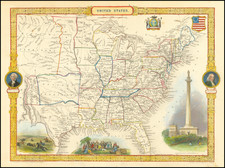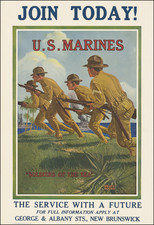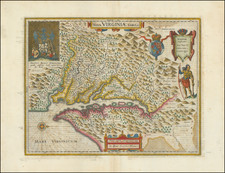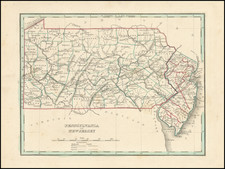Important early map showing Fort Duquesne ("now called Pittsburg").
Fort Duquesne played a central role in the French & Indian War (1754-63), a contest between Britain and France for the domination of North America. The fort was built in 1754, at the origin of the Ohio River at the confluence of the Monongahela and Allegany River, to guard the eastern gateway to the Ohio Country. The location of the fort was unacceptable to the British, who in the summer of 1755 sent an expedtion led by General Edward Braddock to capture the fort. At the Battle of Monongahela on July 9, at the site on the map named "Braddock's Field", the British were decisively defeated by a Franco-Native American force. Braddock was killed and on his deathbed he gave his silk sash to his young aide-de-camp, George Washington. Washington wore the sash almost everyday for the rest of his life.
The map was published shortly after the British seizure of the area in the fall of 1758. That season, the British dispatched a force to take Fort Duquesne. While these initial efforts were unsuccessful, the French realized that their situation was untenable and abandoned and destroyed the fort (so as to prevent it from falling into British hands). British General John Forbes took possession of the area on November 25, 1758, and renamed the location "Fort Pitt", after the de facto British Prime Minister, William Pitt.
The map was issued in the January edition of 'The Grand Magazine of Magazines. or Universal Register', and accompanied an account from General Forbes describing his success. Curiously, Forbes failed to mention that the initial British force was crushed by the French two months before Forbes's arrrival.
It is interesting that his account was published in London, illustrated with a map, barely two months after the siege, thus illustrating the great speed of the London printing industy during the period. The map even notes the decision to rebuild the fort and name it ''Pittsburg'' after William Pitt, making it a very early reference to Pittsburgh.
The Grand Magazine of Magazines. Or Universal Register, mostly written by David Henry, was published as a competitor to the Gentleman's Magazine, and had ceased publication by 1760.










![[Vermont schoolgirl manuscript map of the United States by Lucy Hosford of Ely, VT]](https://storage.googleapis.com/raremaps/img/small/85583.jpg)



